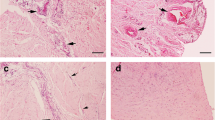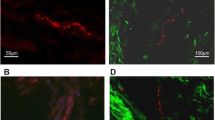Abstract
Substance P, a neuropeptide, exerts proinflammatory effects and transmits the sensation of pain. Substance P immunoreactive fibers of the synovial tissue were examined to investigate the significance of Substance P in the traumatic joint. Biopsy specimens from 15 patients (eight female and seven male) with anterior cruciate ligament (ACL) injury were examined immunohistochemically with semi-quantitative counting to correlate Substance P positive fibers of the synovial tissue with clinical data, pain intensity on a visual analog scale, and serous inflammatory indicators. The total (sum of the three compartments) expression of Substance P in females of 571.9±255.1 cm−2 was significantly greater than that of males of 241.2±126.6 cm−2. In the female group, the total number of Substance P immunoreactive fibers was significantly correlated with pain intensity (r=0.804); in the male group, there was no significant correlation with pain intensity. The expression of Substance P in the female infrapatellar fat pad was statistically significantly correlated with pre- and postoperative erythrocyte sedimentation rate as inflammation indicators. In the male group, there was no such correlation. Substance P was well- correlated with pain and inflammatory reaction in the female joint. Neural inflammation and neural pain occur more strongly in female joints.






Similar content being viewed by others
References
Ackermann PW, Finn A, Ahmed M (1999) Sensory neuropeptidergic pattern in tendon, ligament and joint capsule. A study in the rat. Neuroreport 13(10):2055–2060
Binder W, Carmody J, Walker J (2000) Effect of gender on anti-inflammatory and analgesic actions of two kappa-opioids. J Pharmacol Exp Ther 292:303–309
Bjorling DE, Wang ZY (2001) Estrogen and neuroinflammation. Urology 57(Suppl. 1):40–46
Fayad LM, Parellada JA, Parker L, Schweitzer ME (2003) MR imaging of anterior cruciate ligament tears: is there a gender gap? Skeletal Radiol 32:639–646
Gibson SJ, Polak JM, Bloom SR, Wall PD (1981) The distribution of nine peptides in rat spinal cord with special emphasis on the substantia gelatinosa and on the area around the central canal (lamina X). J Comp Neurol 201:65–79
Henry JL (1976) Effects of substance P on functionally identified units in cat spinal cord. Brain Res 114:439–451
Hyyppa MT, Alaranta H, Lahtela K, et al (1990) Neuropeptide converting enzyme activities in CSF of low back pain patients. Pain 43:163–168
Lotz M, Carson DA, Vaughan JH (1987) Substance P activation of rheumatoid synoviocytes: neural pathway in pathogenesis of arthritis. Science 235:893–895
Lynch EA, Dinrello CA, Cannon JG (1994) Gender differences in IL-1 alpha, IL-1 beta, and IL-1 receptor antagonist secretion from mononuclear cells and urinary excretion. J Immunol 153:300–306
Muneta T, Sekiya I, Yagishita K, et al (1999) Two-bundle reconstruction of the anterior cruciate ligament using semitendinosus tendon with endobuttons: operative technique and preliminary results. Arthroscopy 15:618–624
Otsuka M, Yodhioks K (1993) Neurotransmitter functions of mammalian tachykinins. Physiol Rev 73:229–308
Pinto FM, Armesto CP, Magraner J, et al (1999) Tachykinin receptor and neutral endopeptidase gene expression in the rat uterus: characterization and regulation in response to ovarian steroid treatment. Endocrinology 140:2526–2532
Rugarn O, Hammar M, Theodorsson A, et al (1999) Sex differences in neuropeptide distribution in the rat brain. Peptides 20:81–86
Ziche M, Morbidelli L, Pacini M, et al (1990) Substance P stimulates neovascularization in vivo and proliferation of cultured endothelial cells. Microvasc Res 40:264–278
Acknowledgements
We all thank Ms. Miyoko Ojima for her dedicating contribution to the histological analyses. Also, we appreciate Professor Kenichi Shinomiya for his special support.
Author information
Authors and Affiliations
Corresponding author
Rights and permissions
About this article
Cite this article
Zhang, B., Muneta, T., Yagishita, K. et al. Substance P immunoreactive fibers of synovial tissue in patients with anterior cruciate ligament injury. Knee Surg Sports Traumatol Arthrosc 14, 404–410 (2006). https://doi.org/10.1007/s00167-005-0707-9
Received:
Accepted:
Published:
Issue Date:
DOI: https://doi.org/10.1007/s00167-005-0707-9




